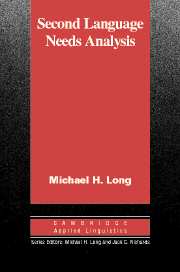Book contents
- Frontmatter
- Contents
- List of contributors
- Acknowledgments
- Overview: A rationale for needs analysis and needs analysis research
- I Methodological issues
- II The public sector
- III The occupational sector
- IV The academic sector
- V Analyzing target discourse
- Chapter 9 Collecting target discourse: The case of the US naturalization interview
- Chapter 10 A double shot 2% mocha latte, please, with whip: Service encounters in two coffee shops and at a coffee cart
- Chapter 11 When small talk is a big deal: Sociolinguistic challenges in the workplace
- Index
Chapter 10 - A double shot 2% mocha latte, please, with whip: Service encounters in two coffee shops and at a coffee cart
Published online by Cambridge University Press: 25 January 2010
- Frontmatter
- Contents
- List of contributors
- Acknowledgments
- Overview: A rationale for needs analysis and needs analysis research
- I Methodological issues
- II The public sector
- III The occupational sector
- IV The academic sector
- V Analyzing target discourse
- Chapter 9 Collecting target discourse: The case of the US naturalization interview
- Chapter 10 A double shot 2% mocha latte, please, with whip: Service encounters in two coffee shops and at a coffee cart
- Chapter 11 When small talk is a big deal: Sociolinguistic challenges in the workplace
- Index
Summary
Introduction
One would think that it is a simple task to order coffee. Intuitively, it is simple. “Can I have a cup of coffee?” seems an appropriate request realization. However, coffee is just not coffee anymore. With the advent of gourmet coffee carts and clever marketing, ordering a coffee is no longer a straightforward process. For the unsophisticated buyer, first-timer, let alone low-proficiency level second language learner, ordering a coffee can be a bewildering experience. There is a myriad of options to choose from: 2% milk, whipped cream, shots of nut or fruit flavored syrups, and double or triple shots of espresso. Your beverage can be iced, either blended, or on the rocks. The sizes are short (very small), tall (small), and venti (extra large). This seems to be a reflection of many service encounters today, where seemingly no order of drinks or food is spared a lengthy list of alternatives.
This study reports on several representative dialogs in two coffee shops and at one coffee cart, which were taken from 168 audio-taped interactions. Their subsequent analysis reveals features found in native speaker to native speaker conversation, common to a variety of specialized and semi-specialized domains of language use. Furthermore, this analysis highlights the inadequacy of model dialogs presented in ESL textbooks, which ill-prepare ESL learners for the realities of everyday interactions. Even though this study focuses on the rather constrained task of ‘buying a coffee’, dialogs pertaining to the purchase of various drinks and snacks have been included.
- Type
- Chapter
- Information
- Second Language Needs Analysis , pp. 305 - 343Publisher: Cambridge University PressPrint publication year: 2005
- 10
- Cited by



